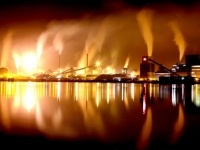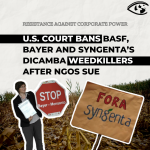Citizens protest Tata Steel’s pollution in Dutch port town

Photo: Joost J. Bakker. Used under Creative Commons license.
When black rain poured down around the Tata Steel plant in IJmuiden, a shipping town in the Netherlands, residents were told that they had no need to worry so long as they kept their windows closed, peeled their vegetables, and washed their hands more frequently. That was in 2018.
Six years later, it has become clear that the plant has been poisoning the surroundings for decades, according to a recent report by the Rijksinstituut voor Volksgezondheid en Milieu (RIVM or National Institute for Public Health and Environment) which concluded that people in IJmuiden have a higher chance of becoming sick because of the Tata Steel plant.
On a day to day basis, RIVM reported that 80 percent of the population suffers from the smell, sound and particles in the air; 40 percent sleep poorly, while children in the area face a higher chance of asthma and neurological damage. The report concluded that residents of Wijk aan Zee, the most affected town, live 2.5 months less than the average Dutch citizen because of the pollution.
“We are talking about all kinds of harms which are one hundred percent attributable to Tata,” Sanne Walvisch, a local activist told Het Parool, an Amsterdam based newspaper.
Community members are outraged. “I am not going to raise my future children in IJmuiden, because I am afraid for their health,” read a message written on a poster carried by a participant at an April 2024 protest.
Another sign at the protest read: “I would like to take daily walks for my health. But in IJmuiden I am under the impression that staying on the couch is better for my health. Bizarre, isn’t it?”
The residents filed criminal charges against Tata Steel in May 2021 and are currently in the process of suing the company for compensation. They also sued the Dutch government in May this year for failing to protect its citizens.
IJMuiden
IJMuiden is a small town in North Holland, located at the end of the North Sea canal. The town was developed in the 1860s when the canal was dug, with royal sponsorship, to create a quicker connection between Amsterdam and the North Sea. Manual laborers from all over the country toiled in abysmal conditions to dig the canal by hand, after which many ended up settling in the town that they helped build.
The town now hosts a steel plant that was built over 100 years ago by a company named Koninklijke Nederlandse Hoogovens, for the purpose of reducing Dutch reliance on imported steel. The plant changed hands a couple of times before it was bought by Tata Steel, which is based in Mumbai, India, in 2007.
Today, Tata plays a critical role in the community because it employs around 9,000 people directly, as well as many more indirectly. Indeed, a recent report titled “De arbeidsmarktverkenning rondom Tata Steel” (The labor market exploration around Tata Steel) published in January 2023 estimates Tata is responsible for 8 percent of jobs in the vicinity of the plant and 3.5 percent in the whole province of North Holland.
But in addition to jobs, the company also has a major impact on the local environment – it operates 13 factories in the area: including Kooksgasfabrieken 1 and Kooksgasfabrieken 2, where coal is heated at 1000 degrees Celsius until it becomes high carbon fuel coke. These two plants are the most polluting of the 13.
Two other towns near IJ Muiden have also been affected by these factories: Beverwijk and Wijk aan Zee, both of which lie to the north of the steel plant on the other side of the shipping channel.
A Series of Reports
A series of reports as far back as 1975 have revealed that this plant has been the source of various health problems over time. The increased frequency of reports in recent years has put a spotlight on Tata, and made this a national issue.
The first government report on carcinogenic emissions from the steel plant was completed as early as 1975, but at the time, the government chose to shelve the study rather than act. The report found that Wijk aan Zee had a concentration of carcinogenic emissions five times higher than at other points measured around the country.
“Fifty years ago it was already clear as day, but environmentalism was in its early phases. People hesitated to do something with it, and then the report disappeared,” Jacob de Boer, a professor in environmental chemistry and toxicology at the Vrije Universiteit, told EenVandaag, a Dutch TV show that uncovered the buried report in 2023.
EenVandaag also published a report showing that lung cancer was 51 percent more prevalent in the area around Tata Steel than in the rest of the Netherlands, by analyzing data from the Netherlands Cancer Institute between 2004-2018.
A third report - a routine analysis of lung cancer in the Kennemerland region conducted by the local Public Health Service in 2021 - was the subject of a major scandal when Het Noordhollands Dagblad (The North Holland Daily), a local newspaper, revealed that all mention of Tata Steel had been deliberately removed from the report. The newspaper also exposed the fact that Tata Steel staff badgered Dutch government officials over the contents of the report, and was given a copy of the final report a day before it was made public.
(Het Noordhollands Dagblad was able to uncover this by using the Freedom of Information law to obtain 31 draft versions of the report together with 345 pages of emails and WhatsApp chats of Public Health Service employees.)
Significantly, the newspaper reported that although Tata Steel was named in the first drafts of the report; Bert van de Velden, the director of the local Public Health Services, had ordered that “the word Tata may not be used.” So despite the fact that the first version of the report identified both the steel factory as well as smoking behavior as the most likely causes of the higher cancer rates, the final version of the report mentions only the latter possibility.
A follow-up government investigation later concluded that removing Tata Steel’s name from the report was justified because van de Velden argued that any mention of the company was likely to be over-hyped in the media. He justified doing this because his agency had not established a definitive cause and effect between the company and the poor health in the region. (The newspaper also highlighted the fact that van de Velden has a standing biannual meeting with Tata management.)
The fourth report, which was published by Onderzoeksraad (the Dutch Safety Board) in early 2023, concluded that Omgevingsdiensten (the Dutch Environmental Inspectorates, which are the government bodies meant to monitor and enforce environmental law on companies) lacked the expertise, manpower and political will to properly oversee Tata, because of years of budget cuts and decentralization. While the report initially focused only on Tata Steel in IJMuiden, the Safety Board realized the issue was not confined to Tata and expanded their review to encompass the Chemours plant in Dordrecht and Asfaltsfabriek plant in Nijmegen. Based on these three cases, the Safety Board concluded that Dutch law is too weak to protect citizens from exposure to harmful emissions.
The fifth – and perhaps the most groundbreaking - report was the RIVM study published in September 2023. It was the first to posit a direct link between Tata Steel and health outcomes in the neighboring towns. “Tata has always denied and downplayed this. Now it has been firmly proven,” Sanne Walvisch from the NGO Frissewind.nu told Het Parool. (Frisewind.nu was founded in January 2021, by concerned parents in the region to combat the company’s pollution. “The emissions of Tata Steel are an invisible enemy present day and night in our direct environment,” it declares on its website).
Tata has not denied RIVM’s findings but company spokespersons have pushed back by noting that the company had not violated legal limits for toxic emissions – and that it was working on reducing emissions. “We have been part of IJmond for generations (...) Because of this, the findings of the RIVM affect us deeply,” the company wrote in a press release.
For example, in 2022 Tata boasted that they had successfully halved their carcinogenic emissions since 2019 after investing €300 million.
However, the RIVM report concluded that there has been no clear measurable effect from the steps that Tata has taken in the last three years.
Lawsuits
The recent revelations have helped inspire local citizens to act. In late June 2023, Gezondheid op 1, an NGO founded by those living around the factory (the name means Put Health First!) sued the Dutch government for forsaking its duty to protect its citizens.
Several other lawsuits have been filed to obtain justice for the community: For example, in 2021, Benedicte Ficq, a famous criminal lawyer, filed charges against Tata on behalf of 800 community members, prompting Openbaar Ministerie (the Dutch Public Prosecution Services) to launch an investigation into the company. That investigation is still ongoing.
Then, in November 2023 Frissewind.nu initiated a mass damages claim against Tata on behalf of 1,400 people affected by the emissions, after the company refused to accept liability for their health impacts.
The reports have also compelled activists to take matters into their own hands in other ways. In March 2024, Frissewind.nu and Greenpeace installed an advanced infrared camera to monitor the emissions of the steel plant 24 hours a day, seven days a week.
Green Steel Plans
Meanwhile Tata recently decided to take advantage of the growing political pressure and concerns about climate change, by offering to upgrade the existing plants to become less polluting, on the condition that the Dutch government cover the costs.
Tata claims that it’s “Green Steel” plan has the potential to slash carbon dioxide emissions by 40 percent by 2030 and achieve carbon neutrality by 2045. Under the plan, Kooksgasfabriek 2 will be closed in 2030, and the blast furnaces will be replaced with electric ovens and Direct Reduced Iron (DRI) technology in order to substitute the polluting coal first with natural gas and eventually with “green” hydrogen.
The cost of Tata’s transition plan - estimated at €2.5 billion - has already gained majority support in the Dutch parliament.
But local residents are upset that the government is likely to accept and even pay for the Tata plan. The activists say that Tata Steel’s plan is not sufficient – noting noting that Kooksgasfabriek 2 is by far the dirtiest factory in the plant and that former Tata employees have revealed that the plant has been malfunctioning ever since it was first built in 1972.
So some 23,000 community members have signed a Greenpeace petition to the Ministry of Economic and Climate affairs, asking them to ensure that citizens’ health is prioritized.
“It is not acceptable that Tata Steel damages the health of citizens for years, disregards environmental regulations, and then receives billions of taxpayer money for a plan that is demonstrably insufficient. The era in which company profits are prioritized over our health, the climate, and nature, is over,” the petition reads.
A total of 14 organizations, including Frissewind.nu and Greenpeace, have proposed an alternative plan that they have named Gezondheids Ultimatum (Health Ultimatum). Under the alternative plan Kooksgasfabriek 2 would be closed by 2025 and Kooksgasfabriek 1 in 2030. The organizations also propose that production is limited to four million tonnes of steel per year, the quantity that the plant was designed for, rather than the six or eight million tonnes of steel per year that it produces currently.
In addition the activists asked Tata to switch to using Hot Briquetted Iron (instead of natural gas which is also a fossil fuel) before it makes the transition to green hydrogen.



